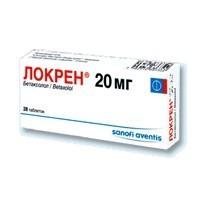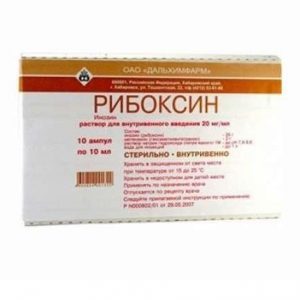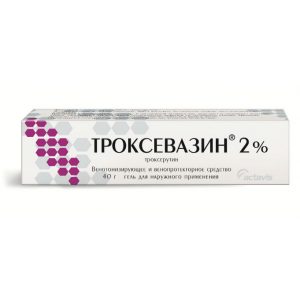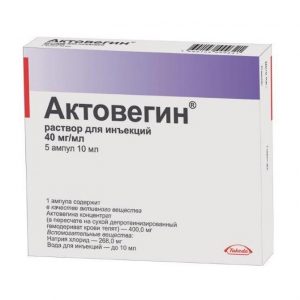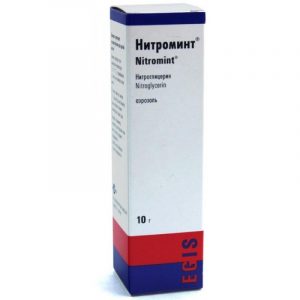Description
Latin name
Lokren
Release form
Coated tablets.
Packing
In a blister pack of 14 tablets. In the package 2 blisters.
Indications
– Arterial hypertension.
– Prevention of angina attacks.
Contraindications
– Chronic heart failure stage II B III.
– Cardiogenic shock.
– AV block II and III degree (without connecting an artificial pacemaker).
– Prinzmetal’s angina pectoris.
– SSSU (including sinoatrial blockade).
– Severe bradycardia.
– Arterial hypotension.
– Cardiomegaly (without signs of heart failure).
– Concomitant use with sultoprid and flactaphenin.
– Concomitant use of MAO inhibitors.
– Age under 18 years of age (efficacy and safety not established).
– Hypersensitivity to betaxolol.
– The drug is contraindicated in congenital galactosemia, malabsorption of glucose / galactose, or lactase deficiency (because lactose is part of).
With caution, the drug is used in patients with a history of allergic reactions, with pheochromocytoma, metabolic acidosis, obliterating peripheral vascular diseases (intermittent claudication, Raynaud’s syndrome), with liver failure, chronic renal failure, during hemodialysis, myasthenia gravis, and depression (t. h in history), in the elderly, with AV blockade of I degree, with chronic obstructive pulmonary disease (bronchial asthma, pulmonary emphysema), in patients with psoriasis, with chronic se dechnoy insufficiency, hyperthyroidism, diabetes mellitus.
Composition
1 coated tablet contains: Betaxolol hydrochloride 20 mg,
Excipients: lactose monohydrate, sodium amylopectin glycolate, microcrystalline cellulose, colloidal anhydrous silicon dioxide, magnesium stearate, hypromellose, macrogol 400, titanium dioxide (E171).
Dosage and administration
The average therapeutic dose is 20 mg (1 tab.) 1 time / day.
Upon termination of treatment, a gradual reduction in dose over 1-2 weeks is recommended, especially in patients with coronary artery disease, to prevent the development of withdrawal syndrome (due to the secondary activation of the sympathetic nervous system).
Tablets are taken orally without chewing and drinking plenty of fluids.
In patients with impaired renal function and creatinine clearance (CC) of 20 ml / min or more, as well as in patients with liver failure, Lokren’s daily dose adjustment is not required. However, at the beginning of treatment, it is recommended to conduct clinical observation until equilibrium plasma concentrations of the drug are achieved (on average – 4 days). For patients with severe renal insufficiency (CC less than 20 ml / min) and undergoing hemodialysis, the recommended initial dose of Lokren is 5 mg / day, regardless of the frequency and time of hemodialysis sessions.
Side effects of
From the central nervous system and peripheral nervous system: increased fatigue, weakness, th ovokruzhenie, headache, drowsiness, insomnia, nightmares, depression, anxiety, confusion, or short-term memory loss, hallucinations, asthenic syndrome, muscle weakness, paresthesias in the extremities (with intermittent claudication, Raynaud’s syndrome), tremor.
From the cardiovascular system: sinus bradycardia, palpitations, orthostatic hypotension, impaired myocardial conduction, AV block (up to cardiac arrest), arrhythmias, weakened myocardial contractility, development (or worsening) of symptoms of heart failure (swelling of the ankles, feet, lower legs), a marked decrease in blood pressure, the manifestation of angiospasm (decreased peripheral circulation, cooling of the lower extremities, Raynaud’s syndrome), chest pain.
From the digestive system: dry mucous membranes of the oral cavity, nausea, vomiting, abdominal pain, constipation or diarrhea, impaired liver function (dark urine, yellowness of the sclera or skin, cholestasis), taste change.
From the respiratory system: nasal congestion, difficulty breathing when prescribed in high doses (loss of selectivity) laryngo- and bronchospasm (in predisposed patients).
On the part of the sensory organs: visual impairment, decreased secretion of the lacrimal gland, dryness and soreness of the eyes, conjunctivitis.
From the endocrine system: hyperglycemia in patients with non-insulin-dependent diabetes mellitus, hypoglycemia in patients receiving insulin, hypothyroid state.
Dermatological reactions: increased sweating, hyperemia of the skin, exanthema, psoriasis-like skin reactions, exacerbation of the course of psoriasis.
Allergic reactions: skin rash, itching, urticaria.
Other: back pain, arthralgia, decreased libido, decreased potency, withdrawal syndrome (increased angina attacks, increased blood pressure) rarely – the appearance of antinuclear antibodies (only in exceptional cases it is accompanied by clinical manifestations such as SLE, passing when treatment is stopped).
Drug Interaction
Many medicines can cause bradycardia. This group includes beta-blockers, class IA antiarrhythmic drugs (quinidine, disopyramide), class III antiarrhythmic agents, amiodarone and class III anti-arrhythmic drugs, class IV diltiazem and verapamil, and digitalis glycosides, clonidine, guanfinalcin, guanfalcin, shown for the treatment of Alzheimer’s disease.
Contraindications combinations
When used concurrently with floctafenin (in the event of shock or arterial hypotension caused by floctafenin), beta-blockers can lead to a decrease in the compensatory responses from the cardiovascular system. When co-administered with sultopride, pronounced bradycardia develops (additive effect).
Combinations to avoid When used with calcium channel blockers (bepridil, diltiazem and verapamil), there are automatic disorders (pronounced bradycardia, sinus node arrest), AV conduction abnormalities, heart failure (synergism). This combination can only be used under close clinical supervision and ECG control (especially in the elderly or at the beginning of therapy). When co-administered with amiodarone, the development of contractility, automatism, and conduction disturbances (suppression of sympathetic compensatory mechanisms) is possible.
Combinations to be used with caution
When using halogen-containing inhalants for general anesthesia, it should be borne in mind that the effect of blockade of -adrenoreceptors can be eliminated by beta-blockers during surgery. As a rule, therapy with beta-blockers should not be stopped, and abrupt withdrawal of the drug should be avoided in any case. The anesthesiologist should be made aware of the treatment being performed. When used concurrently with Lockren antiarrhythmic drugs class IA (quinidine, hydroquinidine and disopyramide) and class III (amiodarone, dofetilide, ibutilide, sotalol), some neuroleptics from the phenothiazine group (chlorpromazine, cyamidazine, benzamidazine, cyamidazine thiaprid), butyrophenones (droperidol, haloperidol), other neuroleptics (pimozide), as well as cisapride, difemanyl, erythromycin (for topical administration), halofanthrin, mizolastin, moxifloxacin, pentamidine, spiramycin (for v / v) Amen (for / in of administering a) Increase Perhaps dash ventricular arrhythmia, especially type pyruÑt (at kombynyrovannoy Need therapy Requires STATUS Clinical monitoring and ECG). When co-administered with propafenone, it is possible to develop contractility disorders, automatism and conductivity (due to suppression of sympathetic compensatory mechanisms), which requires control of the clinical condition and ECG. When combined with baclofen, the antihypertensive effect may be increased (blood pressure monitoring and dose adjustments are necessary). When co-administered with insulin and oral hypoglycemic agents, sulfonylureas, it should be taken into account that all beta-blockers can mask the symptoms of hypoglycemia (palpitations and tachycardia). The patient should be warned about the need to increase blood glucose control, especially at the beginning of treatment. When co-administered with cholinesterase inhibitors (donepezil, galantamine, ambenonium chloride, neostigmine, pyridostigmine, rivastigmine, tacrine) may increase the risk of bradycardia (additive action), which requires monitoring of the clinical condition. When combined with antihypertensive agents of central action (clonidine, apraclonidine, alpha-methyldopa, guanfacin, moxonidine, rilmenidine), a significant increase in blood pressure with abrupt withdrawal of antihypertensive drug of central action (it is necessary to avoid abrupt withdrawal of antihypertensive agent). With / in the introduction of lidocaine may increase the concentration of lidocaine in the blood plasma with a possible increase in unwanted neurological symptoms and effects of the cardiovascular system (decrease in metabolism of lidocaine in the liver), which requires control of the clinical condition and ECG and, possibly, control of lidocaine concentration in the blood plasma during treatment with beta-blockers and after its termination. If necessary, the dose of lidocaine is adjusted.
Combinations to take into account
When used together with NSAIDs for systemic use (including selective COX-2 inhibitors), a decrease in antihypertensive effects (inhibition of prostaglandin synthesis and water and sodium retention) may occur. When co-administered with calcium channel blockers, hypotension, circulatory failure in patients with latent or uncontrolled heart failure may develop. Treatment with beta-blockers can minimize reflex sympathetic mechanisms. When used with tricyclic antidepressants (such as imipramine), neuroleptics may increase the antihypertensive effect and increase the risk of orthostatic hypotension (additive action). Co-administration with mefloquine increases the risk of bradycardia (additive action). When combined with dipyridamole (for I / O administration), an antihypertensive effect may be enhanced. At the same time with alpha-blockers used in urology (alfuzosin, doxazosin, prazosin, tamsulosin, terazosin), increases the antihypertensive effect and increases the risk of orthostatic hypotension. When combined with amifostine, an antihypertensive effect may be enhanced. Allergens used for immunotherapy or allergen extracts for skin tests increase the risk of severe systemic allergic reactions or anaphylaxis in patients, receiving betaxolol. Phenytoin, when injected, increases the severity of cardio-depressive activity and the likelihood of reducing blood pressure in patients receiving betaxolol. When co-administered with betaxolol, it decreases the clearance of xanthines (except for dipyllin) and increases their concentration in blood plasma, especially in patients with initially elevated theophylline clearance (eg, under the influence of smoking). The hypotensive effect of betaxolol is weakened by estrogens (sodium retention). When combined with betaxolol, cardiac glycosides, methyldopa, reserpine and guanfacin increase the risk of developing or worsening bradycardia, AV blockade, cardiac arrest. When combined with betaxolol nifedipine, diuretics, clonidine, sympatholytics, hydralazine and other antihypertensive drugs can lead to a significant decrease in blood pressure. When used together, betaxolol extends the duration of the action of non-depolarizing muscle relaxants and enhances the anti-clotting action of coumarins. When combined with betaxolol ethanol, sedatives and sleeping pills increase CNS depression. Concomitant use with MAOI inhibitors is not recommended due to a significant increase in antihypertensive activity, with a break of at least 14 days between treatment with MAOIs and betaxolol. When co-administered with betaxolol, non-hydrogenated ergot alkaloids increase the risk of peripheral circulation disorders.
Overdose
Symptoms: Severe bradycardia, Dizziness, Severe decrease in BP, Arrhythmias, ventricular extrasystole, AV blockade, Fainting state, Heart failure, Shortness of breath, bronchospasm, Cyanosis of finger nails and palms, Cramps.
Storage conditions
Store at temperatures below 25 ° C out of the reach of children.
Expiration
5 years.
Deystvuyuschee substances
Betaxolol
pharmacy terms for prescription
dosage form
Dosage
form tablets
Sanofi-Aventis, France
